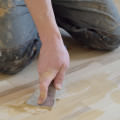Nailing Techniques Used in Home Renovation
The all-mighty nail has a million uses. When it comes to home renovation projects, there’s a good chance that you are going to use nails. This is particularly true if you’re making repairs to fix common problems like squeaking floor boards.
How you use those nails during the course of a renovation can vary however. Use this guide to learn more about common nailing techniques you can take advantage of when updating your home.

Common Nailing Techniques
Face-Nailing Technique
Face-nailing is a simple, efficient nailing technique that’s often the first one you learn. With this technique, you hammer nails directly into the face of the material you’re working with. This leaves nail heads exposed, though they can sometimes be covered up later, depending on the project your working on.
Face-nailing is quick and easy, but it doesn’t produce the strongest joints.
Common uses include:
• Trim installation or repair around walls and doors
• Decorative molding installation or repair around windows or ceilings
• Fastening steps to stair stringers
Toe-Nailing Technique
Toe-nailing is a technique that requires you to use two nails entering the work material at opposing 45-degree angles. This technique is sometimes referred to as slant-nailing. While it is not suitable for creating joints, toe-nailing does create a stronger bond than face-nailing.
Common uses include:
• Interior framing
• Exterior framing
• Fastening wall studs to sole plates
Dovetail Technique
Dovetail nailing also requires two nails driven at opposing angles to create a strong joint. Unlike toe-nailing, dovetail nailing is done on the face of the material you’re working with.
Common uses include:
• Strengthening loose or damaged butt joints
• Cabinetry, shelving and drawer repair and construction
• Furniture construction or repair
Blind Nailing Technique
Blind nailing is a technique most commonly associated with classic tongue-and-groove hardwood floor installation. When using the blind nailing technique, you hammer the nail at a 45-degree angle into the tongue of the wood piece or board you’re working on. Then the groove of the next wood piece or board is placed over the tongue of the last board, effectively covering up the nail.
This technique allows for large expanses of hardwood floor installation without visible nails, making it a go-to technique for high-end homes and commercial spaces.
Common uses include:
• Hardwood floor installation or repairs
• Wood wall or wainscoting installation or repair
• Crown molding and shoe molding installation or repair
Learning common nailing techniques can take the mystery out of home renovation projects you want to take on in your home. Whether you’re doing the work yourself, or hiring a professional with years of experience, understanding more about the process can help you make sound decisions to give your home the look and feel you’re after.
Looking to learn more about nailing techniques for big renovations or new construction projects utilizing hardwood floors? Check out our comprehensive guide on how to nail down hardwood flooring before you begin.
We’ve also got a range of essential products like wood flooring material, tile, moldings and more for every room in your home, as well as all of your outdoor spaces.





